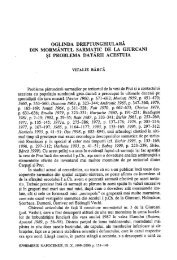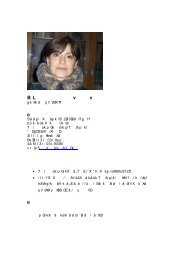EPHEMERIS NAPOCENSIS - Institutul de Arheologie Åi Istoria Artei
EPHEMERIS NAPOCENSIS - Institutul de Arheologie Åi Istoria Artei
EPHEMERIS NAPOCENSIS - Institutul de Arheologie Åi Istoria Artei
You also want an ePaper? Increase the reach of your titles
YUMPU automatically turns print PDFs into web optimized ePapers that Google loves.
Commentaria Archaeologica et Historica (I)<br />
171<br />
The monument from Pergamon is also important for the chronological aspect of this<br />
discussion. Its <strong>de</strong>corative panels illustrate a large range of weapons and military equipment,<br />
Hellenistic and ‘Barbarian’, some of them ol<strong>de</strong>r but still in use at the beginning of the<br />
2 nd century BC, others new and archaeologically documented up to the end of the 2 nd century<br />
or the beginning of the 1 st century BC.<br />
In conclusion, returning to the warrior buried at Ciumeşti, it has to be noted that the<br />
funerary inventory points to his belonging to a warlike elite displaying well <strong>de</strong>fined and visible<br />
signs of status. Still, these have to be interpreted from two different perspectives.<br />
The chainmail and the helmet <strong>de</strong>corated with a bird of prey were symbolic elements<br />
<strong>de</strong>signed to set him apart within the group of warriors from both its own community and on a<br />
wi<strong>de</strong>r area in the Carpathian Basin. The remaining graves with weapons from Ciumeşti (no. 9<br />
and 12) contain ‘standard’ panoplies of weapons of the period, commonly encountered in other<br />
cemeteries from the Carpathian Basin or other areas in temperate Europe: sword (sometimes<br />
with the chain-belt), spear head and shield 46 . For this reason the military equipment of the<br />
mentioned <strong>de</strong>ceased can be consi<strong>de</strong>red insignia of a chieftain having a significant authority in<br />
his community, and perhaps even on a larger area.<br />
On the other hand the greaves were also symbols of his rank, but of different nature<br />
than the local traditional equipment. It may be presumed that during his peregrinations in the<br />
eastern Mediterranean, and the military actions in which he was involved, the warrior from<br />
Ciumeşti, as head of a unit of mercenaries, must have compared himself with the Greek officers<br />
fighting alongsi<strong>de</strong> him. Aiming to be perceived as equal to these officers (perhaps also mercenaries<br />
hired by the same master), he adopted the insignia of the prominent military function<br />
which were comprehen<strong>de</strong>d and acknowledged as such by his Greek colleagues.<br />
Lastly, it has to be noted that in the 50 years which passed since the discovery, the grave<br />
with helmet from Ciumeşti continues to <strong>de</strong>termine numerous scientific <strong>de</strong>bates and to attract<br />
the public interest whenever it is presented in exhibitions, catalogues or books of general interest,<br />
due to its spectacular inventory.<br />
2. The Pa<strong>de</strong>a-Panagjurski kolonii group in Transylvania. Old and new discoveries<br />
Nearly four <strong>de</strong>ca<strong>de</strong>s ago Z. Woźniak noted the spread of some cremation graves containing<br />
panoplies of weapons consisting of swords of La Tène type, spears, shields and curved daggers<br />
(sometimes <strong>de</strong>corated) on the territory of today Bulgaria (mainly in the north and north-west) and<br />
Romania (mainly in Oltenia). In many cases the inventories also contained horse-bits of local type,<br />
indicating that the graves belonged to ri<strong>de</strong>rs. The entire phenomenon was named ‘Pa<strong>de</strong>a-Panagjurski<br />
kolonii’ and was dated mainly to the 2 nd –1 st centuries BC 47 . Still it was noted that during this period<br />
some elements of the funerary rite and ritual were different from a zone to another (tumuli in<br />
north-western Bulgaria, cremation graves in pit, sometimes with the burnt remains placed in urns in<br />
Oltenia etc), suggesting the existence of different traditions and ethnic origins of the members of the<br />
warlike elites which used an otherwise unitary, typologically and functionally, military equipment.<br />
Later discoveries revealed that the mentioned phenomenon was exten<strong>de</strong>d over a wi<strong>de</strong>r<br />
area, including both banks of the Danube in the Iron Gates region, areas in western and southern<br />
Muntenia, and south-western Transylvania 48 .<br />
46<br />
ZIRRA 1967, 24–28 (Grave 9 – complete panoply), 29–32 (Grave 12 – only a sword).<br />
47<br />
WOŹNIAK 1974, 74–138; WOŹNIAK 1976, 388–394. It was later noted that sometimes the military<br />
equipment also contained helmets and chainmails: RUSTOIU 1994a, 34–35; RUSTOIU 1996, 36, 147–150 etc.<br />
48<br />
RUSTOIU 1994a; RUSTOIU 1994b; SÎRBU/RUSTOIU 1999 (with bibliography); RUSTOIU 2002,<br />
11–23; RUSTOIU 2005, 110 Fig. 1; RUSTOIU 2008, 147 Fig. 73 (distribution map).















